Prize draws and competitions are all over the web nowadays, offering you exciting opportunities to win anything from the latest tech to once-in-a-lifetime holidays. But what are the rules for competitions and how can you know that you’re entering a legitimate comp and not falling into a scam trap, or dealing with a dodgy website?
With scammers becoming increasingly clever by the way, there are a number of important things to look out for when entering comps, whether the competition is free or paid. Even well-established sites can sneak questionable points into the small print, or fail to meet the CAP Code, the rule book for non-broadcast advertisements, sales promotions and direct marketing communications.
Before you hand over your valuable data, here are some key points to check:
Quick navigation
- Is the site secure?
- Are you looking at the right website?
- Is the site professional?
- Is the promoter registered?
- Are they ICO registered?
- Do they have a social media presence?
- Is it clear who runs the website?
- Are they using fake reviews?
- Do the prizes really exist?
- Is it clear what you can win?
- Are the terms and conditions clear and fair?
- Does the promoter reserve a right to extend or cancel?
- For paid draws, is there a clear free mode of entry?
- For paid competitions, are the odds clear?
- Is the competition transparent as to entries?
- Is it clear how the winner is chosen?
- Will they sell your data?
- Are their free draws really free?
- Did you even enter the competition?
Is the site secure?
Ensure the competition is hosted on a secure website – look for “https” in the address bar.
In Firefox, the padlock indicates that the site is secure and clicking on it gives further information:
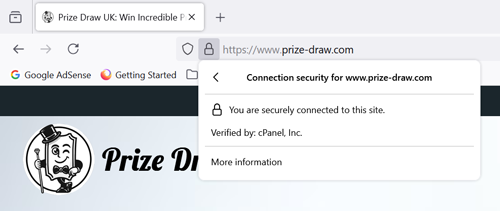
In Chrome, sometimes the ‘https’ element is hidden until you click on the URL. In addition, there is a little slider icon next to the URL which you can click for further information:
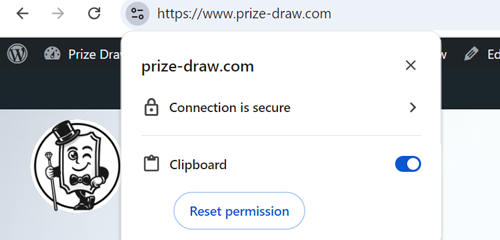
In Microsoft Edge, there is also a little padlock to indicate the site is secure, that you can click to check for more info:
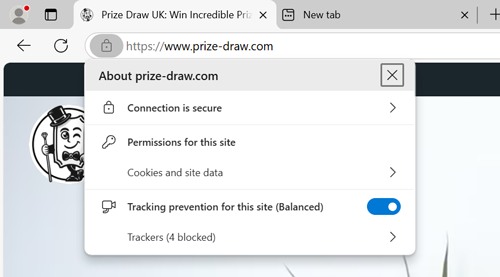
Without a secure connection, any data sent between your browser and the website is not encrypted. This makes it easier for hackers to intercept sensitive information like login details, payment information, or personal data. There is also a higher risk of ‘man-in-the-middle’ attacks, where a hacker intercepts and alters the communication between you and the website.
Are you looking at the right website?
One common trick scammers use is creating fake or spoof websites that look almost identical to the real thing. These sites are designed to steal your personal information or make you think you’re entering a genuine competition when you’re not. To avoid this, never trust links sent to you directly via email, text, or social media messages, especially if you didn’t request them.
Instead, search for the website, e.g. ‘prize-draw.com’, directly on Google or another search engine. This way, you’re more likely to land on the official site, rather than a cleverly disguised fake one. Always double-check the website’s URL – look for small changes like missing letters or additional characters, as these are common in spoof sites.
It’s also helpful to bookmark legitimate competition sites you trust and always use these bookmarks to visit the site, rather than relying on third-party links.
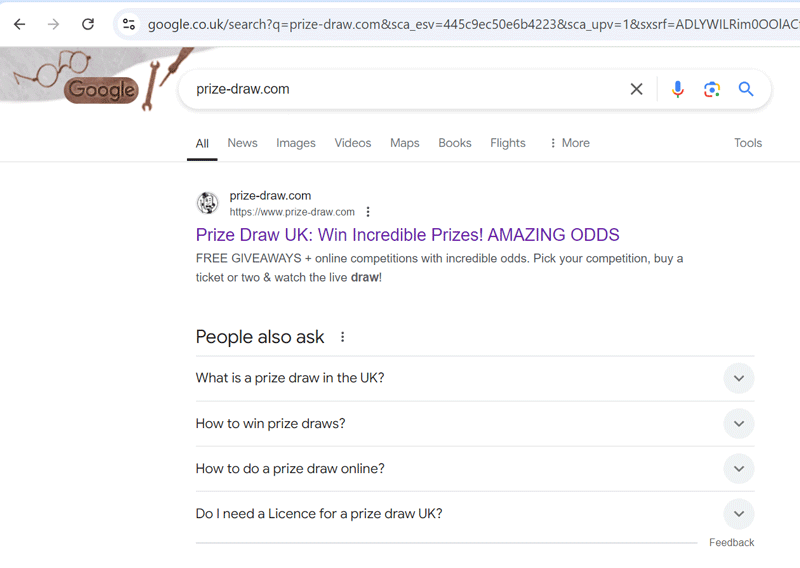
Is the site professional?
While there are many inexpensive or free website-building tools that allow anyone to set up a site quickly, creating a clean, professional, and user-friendly platform takes more time and effort. A professional website is one indicator of a professional business (although shouldn’t be taken as evidence alone).
Be cautious of websites that appear rushed or poorly designed. Common red flags include low-quality images, inconsistent formatting, and cluttered layouts. Additionally, a website filled with spelling mistakes, grammatical errors, or broken links can be a sign that the site may not be legitimate. These issues suggest a lack of attention to detail and can indicate that the promoters are not running a trustworthy or well-organised operation.
A professional-looking site with clear navigation, well-written content, and a polished appearance demonstrates that the promoter has invested in creating a credible and reliable experience for users. But don’t rely on this alone – check other factors too.
Is the promoter registered?
Check to see if the promoter is a registered UK company. A registered UK company is subject to legal regulations and oversight, reducing the risk of fraud. It must disclose key information publicly, such names of directors and persons with significant control (such as major shareholders), annual financial statements showing the company’s financial health, and confirmation statements that outline the company’s structure and shareholders. Companies must also provide a registered office address where legal documents can be served. All of this information is publicly available via Companies House.
Companies are obliged to display their registered number, registered office address, where the company is registered (e.g. England and Wales) and the fact that they are a limited company on all business letters (including emails), order forms and their websites. This information might be in the footer of their website, on their ‘About’ page, in their terms or on their privacy page.
You can search the Companies House register for free here.
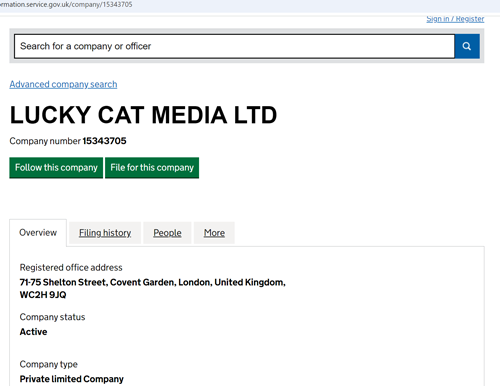
Check that the registered address matches the registered address given on the website (e.g. for example, in their terms). Note that the address for free competition entries may be different to the registered address and this is perfectly normal.
Are they registered with the ICO?
Most promoters will also need to be registered with the the Information Commissioner’s Office (ICO). Registration is a requirement if the promoter processes personal data.
Compers often provide sensitive personal details when entering competitions, such as names, addresses, and phone numbers. ICO-registered companies are required to implement measures to protect this information from unauthorised access or theft.
The promoter’s company should have a registration number, although you can check their registration on the ICO website here.
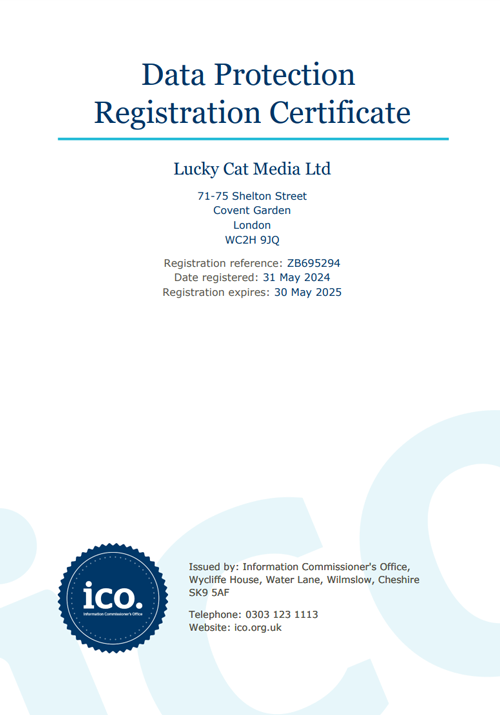
Do they have a social media presence?
A strong social media presence is one indication that a promoter is active, engaged, and transparent. This gives compers some confidence that the company is legitimate and not a scam.
Having a lot of followers alone is not much of a trust factor since it is quite easy to pick up followers using paid posts. Instead, check if the social media profiles show real interactions with compers.
Is it clear who runs the website?
Transparency is a key sign of a trustworthy prize draw site. Legitimate promoters will clearly display who they are and how you can contact them. Look for information about the company behind the competition – such as an “About Us” page, with profiles of the team members running the site.
If there’s no mention of who is behind the site, or if they are using generic names and stock images, this could be a red flag. A legitimate company should be willing to put real names and faces to the business, providing you with contact information like a customer service email address. Be cautious of websites where it’s difficult to find out who is actually running things or where the information seems vague or deliberately hidden.
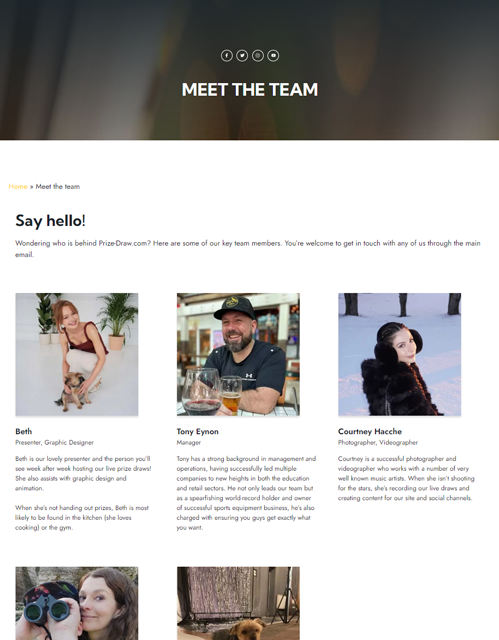
Are they using fake reviews?
We make no secret of the fact that we’re a new company and therefore we have very few reviews. We do find it amazing how many glowing reviews many of the big competition sites have on Trustpilot and similar sites. When many of the draws have as many as 35,000 tickets, how can almost every reviewer be a winner? What’s even more surprising is how often these reviewers have no other activity or reviews outside of that one.
A quick search on Google for ‘buy Trustpilot reviews’ may offer one possible answer as to why this happens. As we are committed to transparency, we won’t be purchasing thousands of reviews to inflate our profile – we’d rather wait for you guys to give us a genuine review in time.
Do the prizes really exist?
It’s very easy for promoters to post photos of prizes taken straight from retail sites like Amazon or Argos, but this alone offers no real assurance that the prize actually exists.
To avoid being misled, look for signs that the company has already purchased the prizes. For example, genuine companies often post their own photos showing the physical prize, such as a picture of the item in their office or a branded location. They may even include unboxing videos or images of the prize alongside their branding to prove ownership. These can give you additional confidence that the prizes are real and will be awarded as promised. If these signs are missing, it might be a red flag that the prize has not really been purchased or secured.
We try to get our own pics up of most of our prizes quickly but as we’re ordering new ones all the time, sometimes we do use the brand photos. However, all of our prizes are here and if you’d like to see a photo of any of them, drop us a quick email to [email protected] and we’ll take a snap of us with the prize for you.

Is it clear what you can win?
A common tactic employed by many larger prize draw sites is to advertise an inflated ‘prize pool,’ particularly when it comes to instant wins. At first glance, it might seem like there are thousands of pounds worth of prizes up for grabs, but when you dig deeper into the actual prize breakdown, it becomes clear that a significant portion of this value is often made up of site credit rather than tangible prizes.
What is site credit?
Site credit is essentially a coupon or voucher that can only be used on the competition site itself. While this might seem appealing at first, it’s important to recognise that it doesn’t equate to real cash or physical goods. Instead, site credit often compels winners to reinvest in more competitions, essentially turning their “win” into an obligation to continue spending on the same platform.
Inflated prize pools
By including large amounts of site credit in the total prize pool, some competition websites create the illusion of offering far more value than they actually do. For example, a competition might advertise a total prize pool of £100,000, but a closer look reveals that a substantial portion (sometimes even the majority) is made up of site credit. In some cases, this site credit is valued at just under the cost of entry, further reducing its perceived value.
Thousands of ‘winners’
Another consequence of relying heavily on site credit is that websites can claim to have “thousands of winners” over time. While this may technically be true, most of these winners may have only received small amounts of site credit, which means that the actual number of people winning meaningful prizes is much lower. This tactic inflates the site’s reputation, making it seem as though it’s constantly paying out prizes when, in reality, many winners are just getting what amounts to a discount on future entries.
Transparency matters
Legitimate prize draw websites should clearly disclose what proportion of their prize pool (if any) is made up of site credit versus actual cash or physical prizes. Before entering, it’s essential to understand the true value of what you could potentially win. If the promotion fails to clearly distinguish between site credit and real prizes, or if the actual odds of winning a meaningful prize are buried in the fine print of the competition rules, this could be a red flag.
When evaluating a competition, ask yourself:
- How much of the prize pool is real cash or physical goods?
- How much is site credit, and can it be redeemed for anything other than more tickets?
- Is the value of the site credit worth the ticket price, or is it just a way to get people to keep entering competitions?
Being aware of these practices will help you make more informed decisions about which competitions to enter and what your chances of winning something valuable really are.
Are the terms and conditions clear and fair?
One of the most important things to check before entering a prize draw is whether the competition rules – the terms and conditions (T&Cs) – are clear and accessible. According to the CAP Code, promoters must include all significant conditions or information upfront, especially if leaving them out them could mislead consumers. This means any costs, eligibility requirements, or deadlines should be easy to find and understand.
Promoters are required to ensure T&Cs “must not be too complex to be understood” and should be accessible for the entire duration of the promotion (CAP Code rule 8.28). If key details, such as how the prize will be awarded or any associated delivery fees, are buried or hard to find, this could be a red flag. The rules state that the structure of the promotion must not only be fair but also “conducted under proper supervision” and must avoid causing unnecessary disappointment (Rule 8.2).
Another crucial aspect is whether all significant conditions are included. As noted in the guidance, “phrases like ‘subject to availability’ are insufficient” when it comes to promotional items. Promoters must be clear about availability and should not change the terms halfway through a promotion (see below on extending draws or closing them early). If the terms are altered after the promotion starts, this could disadvantage consumers who entered in good faith.
Finally, transparency is key when it comes to prize promotions. Winners must be chosen fairly, prizes must be awarded as described, and there must be no room for confusion between gifts and prizes. According to the CAP Code, “promoters must not exaggerate consumers’ chances of winning prizes or claim or imply that consumers are luckier than they are.”
In summary, clear and accessible terms and conditions are a hallmark of a legitimate and well-run competition. If the terms are vague or overly complicated, you should proceed with caution.
Does the promoter reserve a right to extend or cancel?
Under the CAP Code rule 8.17.4.e, closing dates for competitions must not be changed unless:
- Unavoidable circumstances beyond the control of the promoter make it necessary; and
- Not to change the date would be unfair to those who entered with the original closing date – or those who entered with the original terms would not be disadvantaged by the change.
An example of this would be for a paid competition: closing the competition early when all the tickets have been sold would not disadvantage those people who had purchased a ticket – in fact, they would likely be quite pleased of the opportunity to get their prize early! However, closing or cancelling the competition because the promoter has not sold enough tickets clearly would – the ASA has made this ruling on multiple occasions.
Circumstances beyond the promoter’s control would have to be fairly substantial to qualify, such as unexpected snowfall or flooding preventing delivery trucks delivering promotional product packs for an on-pack prize draw promotion arriving in store (ASA).
We would not expect a trustworthy and legitimate website to include a general clause in the competition rules or terms allowing the competition to be extended or cancelled. However on taking a deep dive into the terms of the top 25 prize draw sites in the UK, we did indeed find that most included terms allowing them to either extend the competition or end the competition early for any reason and refund entrants or worse, give them ‘site credit’. We think this is unfair and we don’t think it meets the requirements of the CAP code.
Draws should take place on the agreed date, regardless of the number of entrants at that time – because some people will enter purely because fewer tickets have been sold. Additionally it may be that they don’t want site credit to enter a different competition, which likely would have a later closing date and might also be cancelled.



For paid draws, is there a clear free mode of entry?
Lotteries need a license unless they are strictly for good causes, while prize competitions and free draws are exempt from licensing but must meet specific conditions
In the UK for pay-to-enter competitions, to avoid being classed as a lottery under the Gambling Act 2005, promoters have two choices: they can either offer a free mode of entry, or they must ask a question that requires such a level of skill or judgment that a significant proportion of people will be prevented from entering the competition (this is to avoid the result of the competition being purely down to chance).
If they decide to offer a free mode of entry, this should be clearly visible on the website rather than buried deep in the competition rules or terms. It must be prominently displayed and publicised clearly enough on the website so as to come to the attention of those considering entering competitions on the site. Otherwise, the competition may be an illegal lottery.

The free mode of entry may specify that you have to send one communication (letter, postcard) per entry that has a first or second class stamp. This is compliant with the Gambling Act 2005. They cannot specify that you must use some other more expensive service (such as registered post). Alternatively the free mode may allow you to call or text to enter but crucially, this method must be charged at the ‘normal rate’; there can be no additional payment over what it would normally cost to use that method of communication
If the promoter instead uses a question, this should be sufficiently challenging that you would expect a significant number of people to get it wrong. Alternatively they might require that you submit some text (such as a poem) or a photo for example, which is perfectly acceptable. If they simply ask an easy throwaway question and there is no valid free mode of entry, again this may be an illegal lottery.
“…there are some competitions that ask just one simple question, the answer to which is widely and commonly known or is blatantly obvious from the material accompanying the competition. The Commission considers that these do not meet the test in the Act.”
For paid competitions, are the odds clear?
Check if the competition rules clearly state whether there’s a cap on total entries. Some shadier sites might hide or obscure this information to artificially inflate competition odds or prevent people from understanding their chances of winning.
Changes to the odds (increasing the number of people allowed to enter) after people have already entered the competition would disadvantage those people who entered originally, and would therefore be a clear breach of the CAP code.
Is the competition transparent as to entries?
Transparency in prize draws is essential to build trust and confidence among participants. A legitimate and transparent competition should provide clear visibility on the following:
- Your ticket number(s): Participants should be able to see their assigned ticket number to ensure they are entered into the draw.
- Other entrants: It’s important that the total number of entrants, and ideally a list of ticket numbers, is visible to ensure the competition is fair and all entries are accounted for.
- Total tickets entered: Promoters should make it clear how many total tickets were entered into the competition, providing reassurance that the draw is based on the full pool of entries.
- Draw process: When the draw takes place, participants should be able to see that it was conducted fairly, using the full range of tickets entered. This could be via a live stream or recording of the draw, which verifies that the process was completed transparently from the full set of ticket numbers.
Ensuring these elements are in place adds credibility to the draw and helps participants feel confident that the process is fair.
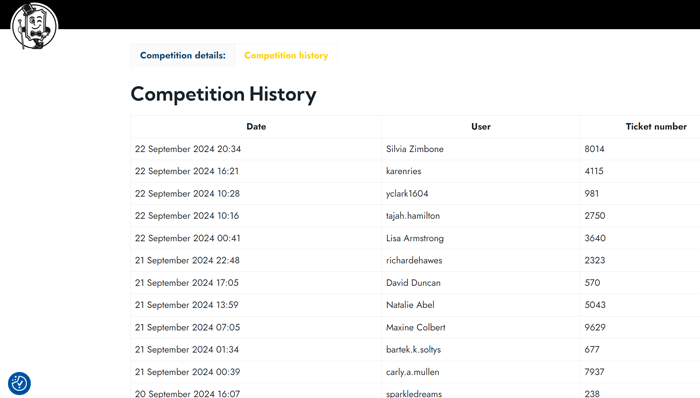
Is it clear how the winner is chosen?
Prize draws must be conducted in a fair and transparent manner, ensuring that winners are selected randomly, as required by law. Promoters should either use a verifiably random computer process, such as a random number generator (RNG), or have an independent observer oversee the selection. The Advertising Standards Authority (ASA) expects promoters to provide evidence if an RNG is used to prove that the process was random and fair (rule 8.24).
Failing to meet these standards can lead to complaints being upheld, as seen in past cases where winners were selected by staff members without independent oversight, which the ASA did not consider fair. Ensuring a transparent, impartial selection process is vital to avoid misleading consumers and to uphold the integrity of the competition.
Prize-Draw.com uses Rafflys software to pick its winners – this is trusted by 11,362+ brands and influencers, including household names like Levi’s and Pepsi. The draw is done live and the drawing process is filmed. We publish a certificate to the website sharing to share the winner, as provided by Rafflys to confirm the draw was completed properly.
Will they sell your data?
A legitimate prize draw company will always respect your privacy and comply with relevant data protection laws like GDPR. However, some scam or unethical sites may collect your personal information just to sell it to third parties for marketing purposes. This can result in a flood of spam emails, unwanted calls, or even more serious identity fraud.
Before entering a competition, check the promoter’s competition rules and privacy policy to see how they handle your data. Reputable companies will clearly state how they collect, store, and use your information, and they will give you an option to opt-out of marketing communications. If there’s no privacy policy or the website is vague about data protection, that’s a major red flag.
Be cautious if a promoter asks for unnecessary personal information like your bank account details or passport information. Any payment information should be handled through a secure processor such as Stripe or Paypal (we use Stripe).
Are their free draws really free?
Scammers may claim you’ve won a prize in a free prize draw but then ask for “processing fees” or unusually high delivery costs – this is a common trick.
Rule 8.21.1 of the CAP Code (Committee of Advertising Practice Code) prohibits promotions where consumers incur a cost to claim a prize. For example, charging a consumer to ring and claim their prize is unacceptable (Churchcastle Ltd, 20 February 2013).
It is the opinion of the Gambling Commission that the Gambling Act does not rule out the charge of normal delivery or other normal costs needed to obtain or use the prize. They give the example of where a camera is the prize, requiring the winner to pay normal delivery costs which might be charged if that same camera was bought from a retailer. Another example is that the winner of a car might be required to pay road tax. But there can be no additional payment over what it would normally cost to pay for delivery or use. Any such costs must be very clear in the terms of the prize draw.
An interesting point made by the Gambling Commission is that where a prize draw appears to be a free draw, but the promoter requests large quantities of data before entry to the draw takes place and there is an intention that the data may be sold to third parties, this may not be considered a free draw at all.
Did you even enter the competition?
It is a common scam to send out texts and emails claiming the recipient has won a prize when they didn’t even enter the competition. Keep a spreadsheet of the comps you have entered so you can check.
Texts claiming you’ve won a prize, especially when you haven’t entered a competition, are a common tactic used by scammers. These messages often include a link that takes you to a spoof website designed to steal your personal information or install malware on your device. Always be suspicious of unsolicited texts, especially if they contain urgent language asking you to claim your prize immediately.
Be cautious of direct messages (DMs) on social media claiming you’ve won a competition. Scammers often create fake profiles mimicking brands to trick people into giving away personal details, including credit card numbers. Genuine promoters will never ask for payment to claim a prize. If you’re uncertain about a winning message, it’s best to verify directly with the brand or community forums like Loquax.
Avoid letters or emails claiming you’ve won a prize but asking you to call a premium rate number to claim it. These are designed to keep you on the phone and rack up charges. As we noted above, legitimate promoters will clearly state what you’ve won and won’t require you to make costly calls.
Finally…
Always trust your instincts – if something feels too good to be true, it probably is! You can view all of our competitions here.









